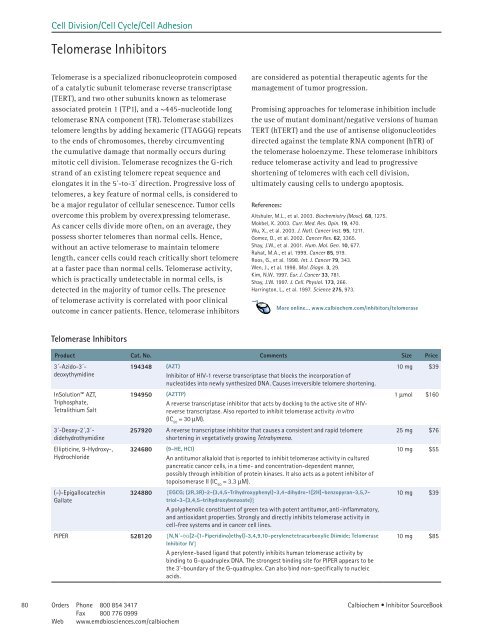Inhibitor SourceBook™ Second Edition
Inhibitor SourceBook™ Second Edition
Inhibitor SourceBook™ Second Edition
You also want an ePaper? Increase the reach of your titles
YUMPU automatically turns print PDFs into web optimized ePapers that Google loves.
Cell Division/Cell Cycle/Cell Adhesion<br />
Telomerase <strong>Inhibitor</strong>s<br />
Telomerase is a specialized ribonucleoprotein composed<br />
of a catalytic subunit telomerase reverse transcriptase<br />
(TERT), and two other subunits known as telomerase<br />
associated protein 1 (TP1), and a ~445-nucleotide long<br />
telomerase RNA component (TR). Telomerase stabilizes<br />
telomere lengths by adding hexameric (TTAGGG) repeats<br />
to the ends of chromosomes, thereby circumventing<br />
the cumulative damage that normally occurs during<br />
mitotic cell division. Telomerase recognizes the G-rich<br />
strand of an existing telomere repeat sequence and<br />
elongates it in the 5´-to-3´ direction. Progressive loss of<br />
telomeres, a key feature of normal cells, is considered to<br />
be a major regulator of cellular senescence. Tumor cells<br />
overcome this problem by overexpressing telomerase.<br />
As cancer cells divide more often, on an average, they<br />
possess shorter telomeres than normal cells. Hence,<br />
without an active telomerase to maintain telomere<br />
length, cancer cells could reach critically short telomere<br />
at a faster pace than normal cells. Telomerase activity,<br />
which is practically undetectable in normal cells, is<br />
detected in the majority of tumor cells. The presence<br />
of telomerase activity is correlated with poor clinical<br />
outcome in cancer patients. Hence, telomerase inhibitors<br />
Telomerase <strong>Inhibitor</strong>s<br />
are considered as potential therapeutic agents for the<br />
management of tumor progression.<br />
Promising approaches for telomerase inhibition include<br />
the use of mutant dominant/negative versions of human<br />
TERT (hTERT) and the use of antisense oligonucleotides<br />
directed against the template RNA component (hTR) of<br />
the telomerase holoenzyme. These telomerase inhibitors<br />
reduce telomerase activity and lead to progressive<br />
shortening of telomeres with each cell division,<br />
ultimately causing cells to undergo apoptosis.<br />
References:<br />
Altshuler, M.L., et al. 2003. Biochemistry (Mosc). 68, 275.<br />
Mokbel, K. 2003. Curr. Med. Res. Opin. 19, 470.<br />
Wu, X., et al. 2003. J. Natl. Cancer Inst. 95, 2 .<br />
Gomez, D., et al. 2002. Cancer Res. 62, 3365.<br />
Shay, J.W., et al. 200 . Hum. Mol. Gen. 10, 677.<br />
Rahat, M.A., et al. 999. Cancer 85, 9 9.<br />
Roos, G., et al. 998. Int. J. Cancer 79, 343.<br />
Wen, J., et al. 998. Mol. Diagn. 3, 29.<br />
Kim, N.W. 997. Eur. J. Cancer 33, 78 .<br />
Shay, J.W. 997. J. Cell. Physiol. 173, 266.<br />
Harrington, L., et al. 997. Science 275, 973.<br />
Product Cat. No. Comments Size Price<br />
3´-Azido-3´-<br />
deoxythymidine<br />
InSolution AZT,<br />
Triphosphate,<br />
Tetralithium Salt<br />
3´-Deoxy-2´,3´-<br />
didehydrothymidine<br />
Ellipticine, 9-Hydroxy-,<br />
Hydrochloride<br />
(–)-Epigallocatechin<br />
Gallate<br />
More online... www.calbiochem.com/inhibitors/telomerase<br />
194348 (AZT)<br />
<strong>Inhibitor</strong> of HIV- reverse transcriptase that blocks the incorporation of<br />
nucleotides into newly synthesized DNA. Causes irreversible telomere shortening.<br />
194950 (AZTTP)<br />
A reverse transcriptase inhibitor that acts by docking to the active site of HIVreverse<br />
transcriptase. Also reported to inhibit telomerase activity in vitro<br />
(IC 50 = 30 mM).<br />
257920 A reverse transcriptase inhibitor that causes a consistent and rapid telomere<br />
shortening in vegetatively growing Tetrahymena.<br />
324680 (9-HE, HCl)<br />
An antitumor alkaloid that is reported to inhibit telomerase activity in cultured<br />
pancreatic cancer cells, in a time- and concentration-dependent manner,<br />
possibly through inhibition of protein kinases. It also acts as a potent inhibitor of<br />
topoisomerase II (IC 50 = 3.3 mM).<br />
324880 {EGCG; (2R,3R)-2-(3,4,5-Trihydroxyphenyl)-3,4-dihydro-1[2H]-benzopyran-3,5,7triol-3-(3,4,5-trihydroxybenzoate)}<br />
A polyphenolic constituent of green tea with potent antitumor, anti-inflammatory,<br />
and antioxidant properties. Strongly and directly inhibits telomerase activity in<br />
cell-free systems and in cancer cell lines.<br />
PIPER 528120 {N,N´-bis[2-(1-Piperidino)ethyl]-3,4,9,10-perylenetetracarboxylic Diimide; Telomerase<br />
<strong>Inhibitor</strong> IV}<br />
A perylene-based ligand that potently inhibits human telomerase activity by<br />
binding to G-quadruplex DNA. The strongest binding site for PIPER appears to be<br />
the 3'-boundary of the G-quadruplex. Can also bind non-specifically to nucleic<br />
acids.<br />
0 mg $39<br />
mmol $ 60<br />
25 mg $76<br />
0 mg $55<br />
0 mg $39<br />
0 mg $85<br />
80 Orders Phone 800 854 34 7<br />
Calbiochem • <strong>Inhibitor</strong> SourceBook<br />
Fax 800 776 0999<br />
Web www.emdbiosciences.com/calbiochem



